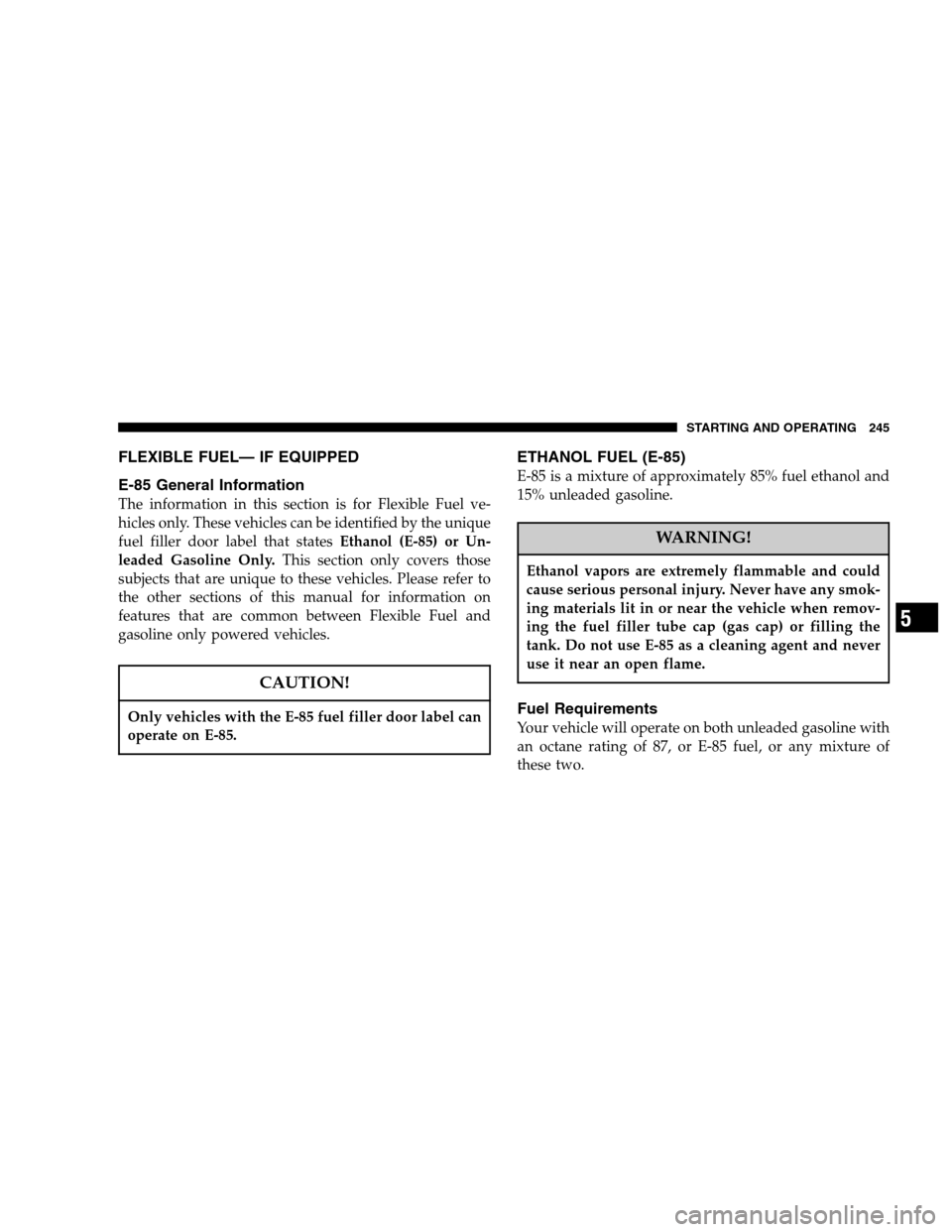Page 106 of 400

Average Fuel Economy (AVG ECO)
Shows the average fuel economy since the last reset. This
display mode becomes less sensitive to instantaneous
changes in fuel consumption as the number of total
vehicle miles since the last reset increases. It is suggested
that this mode be reset periodically for general operation
or when driving conditions change significantly (for
example, at the end of a trip or when a trailer is
connected or disconnected).
Distance To Empty (DTE)
Shows the estimated distance that can be travelled with
the fuel remaining in the tank. The estimated distance is
determined by a weighted average of the instantaneous
and average fuel economy, according to the current fuel
tank level.
When Distance To Empty = LOW FUEL, the fuel gauge
pointer will initially be on the red “E” marker. At this
point (fuel gauge pointer on the the red “E” marker) thereis reserve fuel capacity, which corresponds to approxi-
mately 8% of tank volume. This reserve capacity was put
in place to prevent the likelihood of customers running
out of fuel when operating at maximum load conditions
in areas where there aren’t many gas stations.
NOTE:The Distance To Empty will remain equal to
zero, until the vehicle runs out of fuel or is refueled.
Trip Odometer (ODO)
This display shows the distance traveled since the last
reset.
Elapsed Time (ET)
This display shows the accumulated ignition ON time
since the last reset.
106 UNDERSTANDING THE FEATURES OF YOUR VEHICLE
Page 140 of 400

range (PRND21). If the PRNDL displays only the char-
acters PRND21 (no boxes), have the system checked by
an authorized dealer.
16. Trip Odometer
The trip odometer shows individual trip mileage. To
toggle between the odometer and the trip odometer,
press the Odometer/Trip Odometer Button. To reset the
Trip Odometer, press and hold the button while in trip
mode, until the Trip Odometer resets.
Also the cluster will display, replacing the odometer,
vehicle warning messages such as: door ajar, low wash,
No-fuse, and the outside temperature on vehicles that are
not equipped with the Overhead Console with
Compass/Temperature Mini-Trip Computer. For addi-
tional information, refer to “Compass/Temperature
Mini-Trip Computer” in section 3.
If the vehicle diagnostic system determines that the fuel
filler cap is loose, improperly installed, or damaged,GASCAP will be displayed in the instrument cluster.
Tighten the fuel filler cap properly and press the odom-
eter reset button to turn the GASCAP message off. If the
problem continues, the message will appear the next time
the vehicle is started.
17. Odometer
The odometer shows the total distance the vehicle has
been driven.
U.S. federal regulations require that upon transfer of
vehicle ownership, the seller certify to the purchaser the
correct mileage that the vehicle has been driven. There-
fore, if the odometer reading is changed during repair or
replacement, be sure to keep a record of the reading
before and after the service so that the correct mileage can
be determined.
140 INSTRUMENT PANEL AND CONTROLS
Page 185 of 400

▫Alignment And Balance.................234
�Supplemental Tire Pressure Information – If
Equipped............................235
�Tire Chains...........................235
�Snow Tires...........................237
�Tire Rotation Recommendations............237
�Fuel Requirements......................238
▫Reformulated Gasoline.................239
▫Gasoline/Oxygenate Blends..............239
▫MMT In Gasoline.....................240
▫Materials Added To Fuel................241
▫Fuel System Cautions..................241
▫Carbon Monoxide Warnings..............242�Adding Fuel..........................243
▫Fuel Filler Cap (Gas Cap)...............244
�Flexible Fuel— If Equipped................245
▫E-85 General Information................245
▫Ethanol Fuel (E-85)....................245
▫Fuel Requirements....................245
▫Selection Of Engine Oil For Flexible Fuel Vehicles
(E-85) And Gasoline Vehicles.............246
▫Starting............................246
▫Cruising Range.......................247
▫Replacement Parts.....................247
▫Maintenance.........................247
�Vehicle Loading........................247
STARTING AND OPERATING 185
5
Page 243 of 400
ADDING FUEL
NOTE:If fuel is poured from a portable container, the
container should have a flexible nozzle long enough to
extend into the fuel filler tube.
CAUTION!
To avoid fuel spillage and overfilling, do not “top
off” the fuel tank after filling.
NOTE:When the fuel nozzle “clicks” or shuts off, the
fuel tank is full.
NOTE:Tighten the gas cap until you hear a “clicking”
sound. This is an indication that the gas cap is properly
tightened. Make sure that the gas cap is tightened each
time the vehicle is refueled.
Fuel Cap Holder
STARTING AND OPERATING 243
5
Page 244 of 400
WARNING!
A fire may result if gasoline is pumped into a
portable container that is inside of a vehicle or on a
truck bed. You could be burned. Always place gas
containers on the ground while filling.
Fuel Filler Cap (Gas Cap)
The gas cap is behind the fuel filler door. If the gas cap is
lost or damaged, be sure the replacement cap is for use
with this vehicle.
CAUTION!
Damage to the fuel system or emission control
system could result from using an improper fuel
tank filler tube cap (gas cap). A poorly fitting cap
could let impurities into the fuel system.
WARNING!
•Never allow any lit smoking materials near the
vehicles while removing the cap or filling the
tank.
•Never add fuel to the vehicle when the engine is
running.
244 STARTING AND OPERATING
Page 245 of 400

FLEXIBLE FUEL— IF EQUIPPED
E-85 General Information
The information in this section is for Flexible Fuel ve-
hicles only. These vehicles can be identified by the unique
fuel filler door label that statesEthanol (E-85) or Un-
leaded Gasoline Only.This section only covers those
subjects that are unique to these vehicles. Please refer to
the other sections of this manual for information on
features that are common between Flexible Fuel and
gasoline only powered vehicles.
CAUTION!
Only vehicles with the E-85 fuel filler door label can
operate on E-85.
ETHANOL FUEL (E-85)
E-85 is a mixture of approximately 85% fuel ethanol and
15% unleaded gasoline.
WARNING!
Ethanol vapors are extremely flammable and could
cause serious personal injury. Never have any smok-
ing materials lit in or near the vehicle when remov-
ing the fuel filler tube cap (gas cap) or filling the
tank. Do not use E-85 as a cleaning agent and never
use it near an open flame.
Fuel Requirements
Your vehicle will operate on both unleaded gasoline with
an octane rating of 87, or E-85 fuel, or any mixture of
these two.
STARTING AND OPERATING 245
5
Page 249 of 400

Each axle GAWR is determined by the component in the
system with the lowest load carrying capacity (axle,
springs, tires, or wheels).
Heavier axles or suspension components sometimes
specified by purchasers for increased durability do not
necessarily increase the vehicle’s GVWR.
Tire Size
This is the minimum allowable tire size for your vehicle.
Replacement tires must be equal to the load capacity of
this tire size.
Rim Size
This is the rim size that is appropriate for the tire size
listed.
Inflation Pressure (Cold)
This is the cold tire inflation pressure for your vehicle for
all loading conditions up to full GAWR.
Curb Weight
The curb weight of a vehicle is defined as the total weight
of the vehicle with all fluids, including vehicle fuel, at full
capacity conditions, and with no occupants or cargo
loaded into the vehicle. The front and rear curb weight
values are determined by weighing your vehicle on a
commercial scale before any occupants or cargo are
added.
Loading
The actual total weight and the weight of the front and
rear of your vehicle at the ground can best be determined
by weighing it when it is loaded and ready for operation.
The entire vehicle should first be weighed on a commer-
cial scale to insure that the GVWR has not been exceeded.
The weight on the front and rear of the vehicle should
then be determined separately to be sure that the load is
properly distributed over front and rear axle. Weighing
the vehicle may show that the GAWR of either the front
STARTING AND OPERATING 249
5
Page 273 of 400
WARNING!
•Never allow any lit smoking materials near the
vehicles while removing the cap or filling the
tank.
•Never add fuel to the vehicle when the engine is
running.
•A fire may result if gasoline is pumped into a
portable container that is in a vehicle or on a truck
bed. You could be burned. Always place gas
containers on the ground while filling.
CHANGING A FLAT TIRE
Jack Location
In the Dakota, the scissor jack and tire changing tools for
Club Cab models are stowed in a compartment under the
rear passenger seat. Quad Cab model scissor jack and tire
changing tools are accessed by lifting up the rear passen-
ger seat.
The jack is secured in place by turning the jack screw
until the jack is secured into place.
A finger operated helper tool is provided to assist re-
moval and stowage of the jack. This tool must be
removed to operate the jack for changing the spare tire.
WHAT TO DO IN EMERGENCIES 273
6